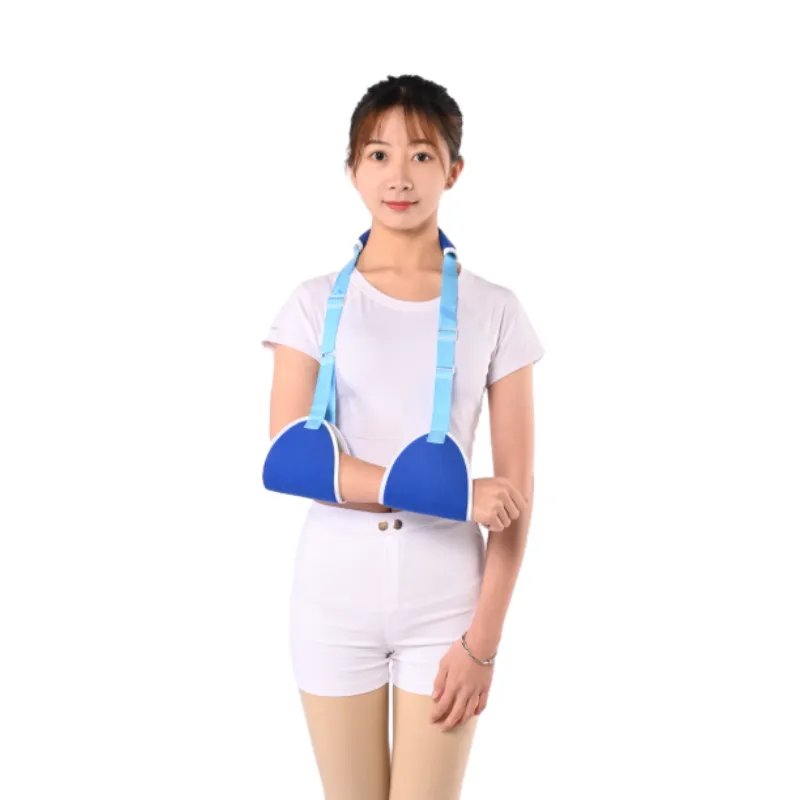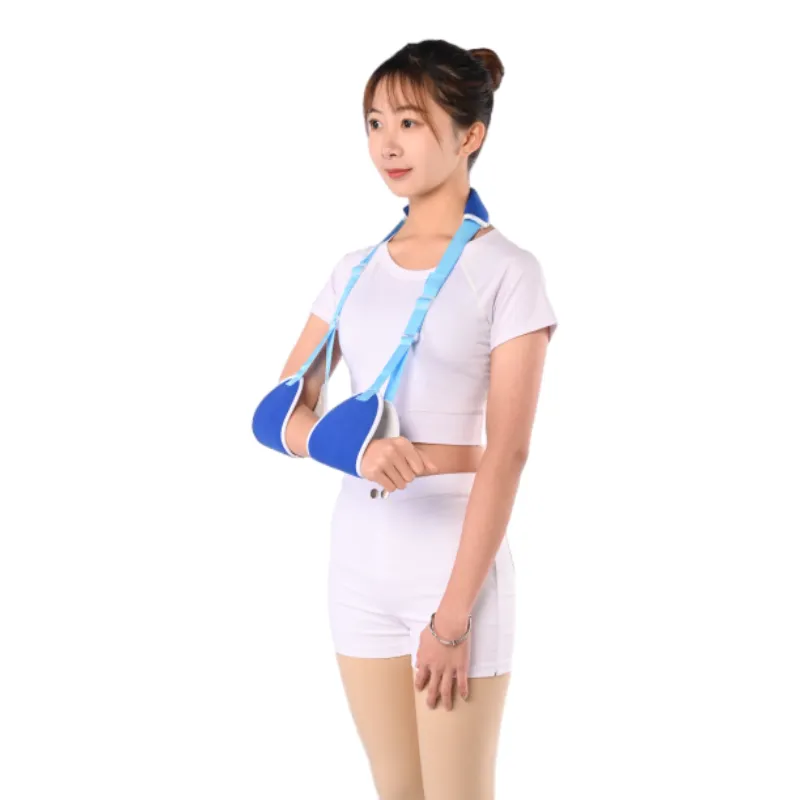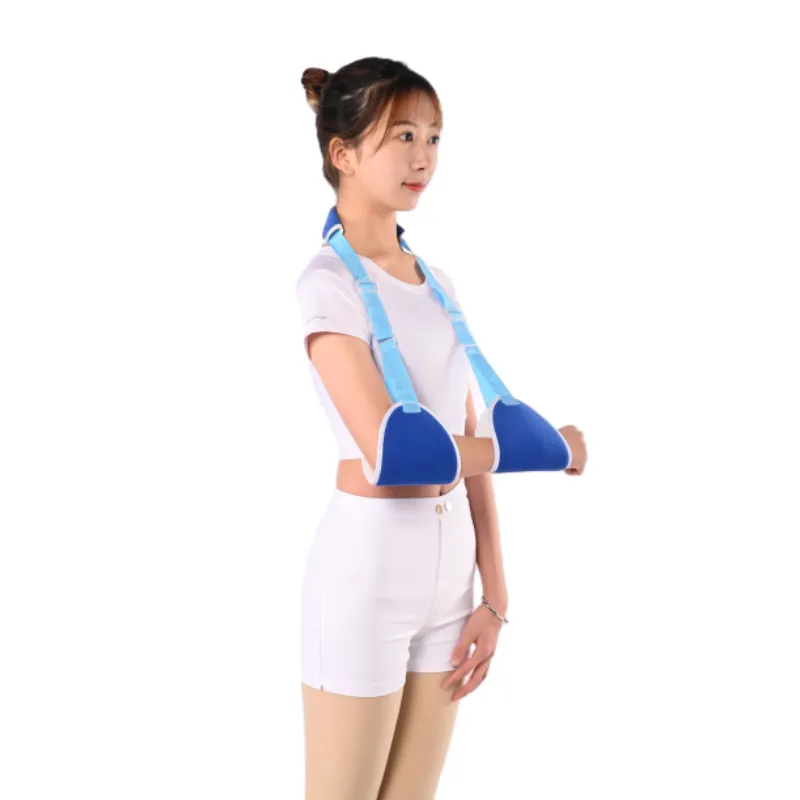Premium Arm Cast with Sling: Adjustable Support for Fast Recovery
Introduction to Advanced Arm Immobilization Solutions
In the rapidly evolving landscape of orthopedic care and rehabilitation, the demand for highly effective and patient-centric immobilization devices is paramount. A crucial component in post-traumatic and post-operative recovery, the arm cast with sling serves as a cornerstone for ensuring proper healing, reducing pain, and facilitating optimal functional outcomes. This article delves into the intricate aspects of manufacturing, technical specifications, application advantages, and market trends surrounding these essential medical devices, specifically focusing on solutions tailored for B2B procurement by healthcare institutions, distributors, and rehabilitation centers.
Our discussion will cover the detailed process flow, adherence to stringent quality standards, and the value proposition offered by leading manufacturers. We aim to provide a comprehensive resource for decision-makers seeking advanced, reliable, and cost-effective solutions in orthopedic support.
Industry Trends in Modern Arm Immobilization Technology
The global market for orthopedic bracing and supports is experiencing robust growth, driven by an aging population, increasing sports injuries, and advancements in surgical techniques requiring sophisticated post-operative care. Key trends shaping the development of devices like the arm cast with sling include:
- Enhanced Material Science: A shift towards lightweight, breathable, hypoallergenic, and moisture-wicking materials (e.g., advanced composites, neoprene, perforated foams) that improve patient comfort and reduce skin irritation, a common complaint with traditional casts.
- Modularity and Adjustability: Growing demand for adjustable arm sling designs that can accommodate various arm lengths, body types, and desired angles of elevation or abduction. This includes features like quick-release buckles, customizable strap lengths, and thumb loops for enhanced support. The rise of the abduction arm sling is particularly notable for its role in specific post-rotator cuff repair protocols.
- Ergonomics and Patient Compliance: Focus on designs that are easy for patients to wear, adjust, and maintain, promoting higher compliance rates crucial for successful recovery. Integrated arm sling elbow supports and adjustable arm sling elevation mechanisms are becoming standard to ensure optimal anatomical positioning.
- Cost-Efficiency and Scalability: For B2B clients, the balance between high-quality construction and competitive arm sling price remains a critical factor. Manufacturers are optimizing production processes to deliver superior products at scales suitable for large healthcare networks.
- Integration with Digital Health: While not direct, the broader trend in healthcare towards patient monitoring and remote rehabilitation implicitly drives the need for reliable, comfortable physical supports that complement digital tracking.
Manufacturing Process of a High-Quality Arm Cast with Sling
The production of a high-quality arm cast with sling involves a meticulously controlled process, from raw material sourcing to final assembly and testing. Adherence to strict medical device manufacturing standards is paramount to ensure product efficacy, patient safety, and regulatory compliance.
Process Flow:
-
Material Selection & Sourcing:
Utilizing medical-grade, hypoallergenic, and breathable fabrics (e.g., polyester-cotton blends, specialized nylon, non-irritating foams). Straps are typically made from durable polypropylene webbing, while buckles and adjusters are high-strength plastic or composites. All materials are pre-screened for biocompatibility and durability, crucial for devices with extended service life.
-
Precision Cutting & Shaping:
Advanced CNC cutting machines are employed to precisely cut fabric components according to design specifications. This ensures consistency in sizing and form, critical for effective immobilization and patient comfort. For structural components, injection molding is used for plastic parts.
-
Stitching & Assembly:
Skilled technicians perform industrial stitching using reinforced threads to ensure robust seams that withstand prolonged use. Components such as shoulder straps, forearm cuffs, and thumb loops are carefully assembled. Ergonomic design principles are applied during assembly to ensure the final product correctly supports the anatomy, addressing specific requirements for an arm sling elbow or shoulder support.
-
Fastener & Adjustment Mechanism Integration:
High-quality hook-and-loop fasteners (Velcro-type), quick-release buckles, and ladder locks are integrated to facilitate easy and secure adjustment, paramount for an adjustable arm sling.
-
Quality Control & Testing:
Every batch undergoes rigorous quality control. This includes dimensional verification, tensile strength testing of straps and seams, and functional checks of all adjustment mechanisms. Products must comply with international standards such as ISO 13485 (Medical Devices Quality Management Systems), CE marking for European markets, and FDA regulations for the United States. Testing ensures a reliable service life, typically exceeding 2-3 years under normal usage and proper care.
-
Packaging & Sterilization (if applicable):
Each product is individually inspected, cleaned, and packaged, often in sterile environments for specific medical applications.
Target Industries: Medical device distributors, hospitals (orthopedics, emergency, general surgery departments), rehabilitation clinics, sports medicine facilities, and emergency services.
Advantages in Typical Application Scenarios: For instance, in a busy hospital emergency room, the quick and intuitive design of our arm cast with sling significantly reduces application time, allowing medical personnel to efficiently manage patient flow while ensuring proper initial immobilization. The use of breathable materials also minimizes the risk of skin maceration, enhancing patient comfort during extended wear.

Technical Specifications and Performance Parameters
Understanding the precise technical specifications of an arm sling is critical for B2B procurement, ensuring the device meets the clinical needs of various patient populations and injury types. Below are typical parameters for a high-quality arm cast with sling, often exemplified by a Triangle Arm Sling:
Typical Triangle Arm Sling Specifications:
| Parameter | Description / Value |
|---|---|
| Product Type | Standard Triangle Arm Sling, Adjustable |
| Materials | Polyester-Cotton Blend Fabric (Pouch), Polypropylene Webbing (Strap), High-Impact ABS Plastic (Buckles/Adjusters), Hypoallergenic Foam Padding |
| Sizes Available | Small, Medium, Large, X-Large (Pediatric and Bariatric options often available) |
| Adjustability | Fully adjustable shoulder strap length (approx. 50-100 cm), thumb loop for hand support, variable arm sling elevation capability. |
| Weight Capacity | Up to 25 kg (55 lbs) for standard adult sizes |
| Design Features | Breathable mesh or perforated fabric, padded shoulder strap, integrated arm sling elbow support, quick-release buckle. |
| Compliance & Certifications | ISO 13485:2016, CE Marked, FDA Registered, Biocompatibility Tested (ISO 10993) |
| Maintenance | Hand washable with mild soap, air dry. |
These specifications highlight the focus on both patient comfort and robust clinical functionality. The provision of an integrated arm sling elbow support ensures the entire limb is stabilized, reducing the risk of rotational forces that could impede healing. Furthermore, the adjustable elevation feature allows clinicians to prescribe precise positioning, which is critical for managing swelling and promoting venous return, particularly in cases of distal radius fractures or hand injuries.
Application Scenarios and Target Industries
The versatility and effectiveness of a well-designed arm cast with sling make it indispensable across a broad spectrum of medical and emergency applications. Its primary function is to provide comfortable, secure immobilization and support for the arm and shoulder, facilitating recovery from injury or surgery.
- Post-Operative Recovery: Essential for patients recovering from shoulder surgeries (e.g., rotator cuff repair, shoulder arthroscopy), elbow surgeries, or humerus fracture fixation. The sling maintains the arm in a neutral or specific therapeutic position, crucial for tissue healing and preventing re-injury.
- Fracture Management: Used to support and immobilize the arm following fractures of the humerus, radius, ulna, or wrist. It minimizes movement at the fracture site, promoting bone union.
- Sprains and Strains: Provides vital support for severe sprains of the shoulder, elbow, or wrist ligaments, reducing stress on the injured tissues and alleviating pain.
- Dislocations: Following reduction of shoulder or elbow dislocations, a sling helps maintain the joint in a stable position during the initial healing phase.
- Neurological Conditions: Can be used to support a paretic or paralyzed arm in patients with neurological deficits (e.g., stroke, brachial plexus injury) to prevent shoulder subluxation or maintain comfortable positioning.
- Emergency Care: First responders and emergency medical personnel frequently use arm slings for immediate stabilization of suspected arm or shoulder injuries prior to definitive diagnosis and treatment.
Key Target Industries for B2B Procurement:
- Hospitals: Orthopedic departments, emergency rooms, surgical wards, and general medical supply.
- Orthopedic Clinics & Practices: For patient distribution post-consultation or minor procedures.
- Rehabilitation Centers: For ongoing patient support during recovery phases.
- Sports Medicine Facilities: Catering to athletic injuries and post-sport surgery.
- Medical Device Distributors: Stocking and supplying to a wide network of healthcare providers.
- Home Healthcare Providers: For patients requiring continuous support at home.

Technical Advantages of Advanced Arm Slings
Modern advancements in orthopedic support technology have significantly elevated the functional and therapeutic advantages of the arm cast with sling compared to traditional, less sophisticated designs. These technical improvements directly translate into superior patient outcomes and operational efficiencies for healthcare providers.
- Superior Immobilization & Support: Engineered designs provide multi-directional stability, preventing unwanted movement of the shoulder, elbow, and wrist. This crucial immobilization directly supports fracture healing, reduces strain on surgical repairs, and minimizes pain. The integration of specialized components like an abduction arm sling for specific pathologies ensures precise anatomical positioning.
- Enhanced Patient Comfort & Compliance: Lightweight, breathable, and skin-friendly materials reduce heat build-up and moisture, mitigating skin irritation, maceration, and odor. Padded straps and ergonomic designs distribute pressure evenly, preventing nerve impingement and discomfort, leading to higher patient compliance with prescribed wear times.
- Precision Adjustability: Features such as easily adjustable straps, quick-release buckles, and thumb loops allow for precise fitting to individual patient needs. This includes granular control over arm sling elevation and overall arm position, which is vital for managing swelling and maintaining therapeutic angles.
- Durability & Longevity: Constructed from medical-grade, robust materials and reinforced stitching, these slings are designed for extended wear and multiple cleanings, maintaining their structural integrity and hygienic properties throughout the recovery period, which improves the cost-effectiveness over the product lifecycle.
- Ease of Application for Clinicians: Intuitive design and clear instructions minimize the learning curve for medical staff, ensuring correct and efficient application in busy clinical settings, thereby saving valuable time.
- Versatile Application: While primarily for immobilization, the modern sling’s design adaptability allows for use across a wider range of injuries and post-operative protocols, making it a versatile asset in any orthopedic inventory.
Vendor Comparison and Customized Solutions
Selecting the right supplier for a arm cast with sling is a strategic decision for B2B entities. Beyond the base product, factors such as supplier reliability, customization capabilities, and post-sales support significantly impact the overall value proposition. Here’s a comparative view of key vendor selection criteria:
Vendor Comparison Criteria:
| Criterion | Leading Supplier (e.g., JH Orthopedic) | Standard Supplier |
|---|---|---|
| Certifications | ISO 13485, CE, FDA Registered, Biocompatibility (ISO 10993) | Basic CE or regional approvals, limited ISO scope |
| Material Quality | Medical-grade, hypoallergenic, breathable, durable, moisture-wicking fabrics | Standard synthetic fabrics, potentially less breathable/durable |
| Customization | Brand labeling, custom sizing, material variations, design modifications, bulk order specifics | Limited to no customization options |
| Arm Sling Price (Value) | Competitive pricing with superior material and build quality, long-term value | Lower initial cost, but potentially higher replacement rates or patient discomfort issues |
| Lead Time & Fulfillment | Streamlined production, reliable logistics, capacity for large orders | Variable lead times, limited large-scale capacity |
| After-Sales Support | Dedicated account management, technical support, warranty, efficient returns | Basic support, slower response times |
Customized Solutions:
For large healthcare systems, government tenders, or specialized medical distributors, customization is often a key differentiator. Leading manufacturers offer:
- Private Labeling/Branding: Incorporating client logos and specific packaging designs.
- Size & Material Adaptation: Developing pediatric or bariatric sizes, or using specific material compositions for unique regional requirements or patient sensitivities.
- Design Modifications: Tailoring specific features, such as adding extra padding, specialized pockets, or modifying the abduction arm sling angle for specific surgical protocols.
- Volume-Based Production: Scalable manufacturing capabilities to meet large, recurring orders efficiently.
Real-World Application Case Studies
These illustrative case studies demonstrate how high-quality arm cast with sling solutions deliver tangible benefits for B2B clients and their end-users:
Case Study 1: Large Hospital Network Procurement Optimization
A national hospital network sought to standardize its orthopedic support inventory to improve patient comfort, streamline procurement, and reduce overall costs associated with varied supplier relationships. By partnering with a leading manufacturer offering a comprehensive range of high-quality, adjustable arm slings, the network achieved several key outcomes:
- Reduced Stock Keeping Units (SKUs): The versatility of the adjustable arm sling allowed them to replace multiple specialized slings with a single, highly adaptable model, simplifying inventory management by 30%.
- Improved Patient Satisfaction: Consistent feedback reported higher comfort levels due to breathable materials and superior adjustability, leading to better adherence to treatment plans.
- Cost Savings: Bulk purchasing and consolidated supplier relationships resulted in a 15% reduction in overall procurement expenditure for arm immobilization devices over two years.
Case Study 2: Sports Medicine Clinic Enhancing Post-Injury Rehabilitation
A prominent sports medicine clinic specializing in upper limb injuries required slings that could withstand rigorous use and provide specific support for athletes undergoing rehabilitation. They adopted a supplier's range of durable and ergonomically designed slings, including specialized abduction arm sling models for rotator cuff repairs.
- Accelerated Recovery: The precise immobilization provided by the high-quality slings, particularly those allowing for controlled arm sling elevation, was credited with reducing recovery times for athletes by an average of 10-15% in complex shoulder cases.
- Enhanced Patient Confidence: Athletes reported feeling more secure and confident in their recovery due to the robust support, encouraging earlier engagement in guided physical therapy.
- Durability in Active Environments: The slings demonstrated exceptional resilience to daily wear and tear associated with active rehabilitation, proving to be a reliable component of the clinic's treatment protocols.
Ensuring Trustworthiness & Support
A reliable B2B partnership extends beyond product quality to encompass robust support mechanisms, transparent policies, and consistent communication. Our commitment to trustworthiness is reflected in the following aspects:
Frequently Asked Questions (FAQ) for B2B Clients:
- Q: What are the minimum order quantities (MOQ) for the arm cast with sling?
- A: MOQs vary by product type and customization requirements. Please contact our sales team for detailed information on specific models and bulk pricing.
- Q: Can you provide samples for evaluation before a large order?
- A: Yes, we typically offer samples for qualified B2B clients to ensure product suitability and compliance with their standards. Sample terms will be discussed during initial consultation.
- Q: What certifications do your products hold?
- A: All our medical devices, including the arm cast with sling, are manufactured under ISO 13485 certified quality management systems and are CE marked. Many products are also FDA registered, ensuring compliance with major international regulatory bodies.
- Q: How does your arm sling price compare to competitors?
- A: We offer competitive pricing that reflects the superior quality of materials, advanced manufacturing processes, and comprehensive support. Our focus is on delivering exceptional value and long-term reliability.
Lead Time & Fulfillment:
We pride ourselves on efficient production and robust supply chain management. Standard lead times for stock items typically range from 2-4 weeks, while customized or large-volume orders may require 6-8 weeks, depending on complexity. We work closely with clients to establish realistic timelines and ensure on-time delivery, minimizing operational disruptions for your facility or distribution network.
Warranty Commitments:
All our arm slings are backed by a standard 12-month manufacturer's warranty covering defects in materials and workmanship. This commitment underscores our confidence in the durability and quality of our products, providing peace of mind to our B2B partners.
Customer Support & After-Sales Service:
Our dedicated B2B support team provides comprehensive assistance, including:
- Technical Support: Expertise on product application, features, and specifications.
- Order Management: Streamlined processing, tracking, and logistics coordination.
- Returns & Replacements: Efficient handling of any issues in accordance with our warranty policy.
- Dedicated Account Managers: Personalized service to understand and anticipate your specific business needs.

Conclusion
The modern arm cast with sling is far more than a simple support device; it is a meticulously engineered medical tool critical for effective patient recovery and efficient healthcare operations. For B2B partners, selecting a manufacturer that prioritizes advanced materials, stringent quality control, comprehensive certifications, and robust post-sales support is essential. By investing in high-quality, technically superior arm slings, healthcare providers can enhance patient comfort, accelerate recovery times, and optimize their operational expenditures. We remain committed to advancing orthopedic care through innovation, reliability, and unparalleled customer service.
Authoritative Citations
- International Organization for Standardization. ISO 13485:2016 Medical devices — Quality management systems — Requirements for regulatory purposes. Available from: iso.org
- U.S. Food and Drug Administration. Medical Devices. Available from: fda.gov/medical-devices
- European Commission. Medical Devices Regulation (MDR) (EU) 2017/745. Available from: ec.europa.eu/health/md_sector/overview_en
- American Academy of Orthopaedic Surgeons (AAOS). Available from: aaos.org
- World Health Organization (WHO). Medical Devices. Available from: who.int/medical_devices
-
Shoulder Brace Support Arm Sling for Injury Recovery & Pain ReliefNews Sep.01,2025
-
Back Support Elastic with Lumbar: Comfort, Relief & PostureNews Aug.30,2025
-
JH3500 Wrist Support-Hebei Jianhang Technology Co.,Ltd.|Post-Operative Recovery, Chronic Injury ManagementNews Aug.29,2025
-
JH3500 Wrist Support-Hebei Jianhang Technology Co., Ltd.|Adjustable Compression&Ergonomic DesignNews Aug.29,2025
-
Hard Cervical Collar with Chin: Optimal Neck Support & StabilityNews Aug.29,2025





















